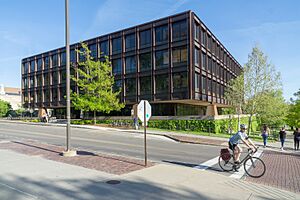SOM (architectural firm) facts for kids
 |
|
| Private | |
| Industry | Professional services |
| Founded | 1936, in Chicago, Illinois, U.S. |
| Founders | |
| Headquarters | Chicago, Illinois, U.S. |
|
Area served
|
Worldwide |
|
Key people
|
Mustafa Abadan, William F. Baker, Thomas Behr, Keith Boswell, Carrie Byles, Larry Chien, Leo Chow, Brant Coletta, Chris Cooper, Paul Danna, Mark Sarkisian, Michael Duncan, Scott Duncan, Laura Ettelman, Xuan Fu, T.J. Gottesdiener, Gary Haney, Craig Hartman, Kent Jackson, Colin Koop, Kenneth Lewis, Adam Semel, Jonathan Stein, Douglas Voigt |
| Services | Architecture, building services/MEP engineering, graphics, interior design, structural engineering, civil engineering, sustainable design and urban design & planning |
| Revenue | $347 million (2021) |
SOM, which stands for Skidmore, Owings & Merrill LLP, is a famous company that designs buildings, cities, and structures. It started in 1936 in Chicago, Illinois, in the U.S. The company was founded by Louis Skidmore and Nathaniel Owings. In 1939, an engineer named John O. Merrill joined them.
SOM is known for creating modern buildings and for its amazing work on skyscrapers. They have designed some of the world's most important buildings and city plans. This includes several of the tallest buildings in the world, like the John Hancock Center (finished in 1969), Willis Tower (finished in 1973, the tallest in the world for nearly 25 years), One World Trade Center (finished in 2014), and Burj Khalifa (finished in 2010, currently the world's tallest building).
SOM's teams work on many different types of projects. They offer services in architecture (designing buildings), engineering (making sure buildings are strong and work well), interior design (designing the inside of buildings), sustainable design (designing buildings that are good for the environment), and urban design & planning (designing cities and towns).
Contents
History of SOM's Designs
Early Years and Modern Style
One of SOM's first important projects was Lever House, completed in 1952 in New York City. It was the first office building in New York to use the "International Style." This style featured lots of glass and steel, which was very different from the brick buildings common at the time. Lever House helped start a new look for tall buildings.
In the 1970s, SOM became a leader in designing skyscrapers. They built the John Hancock Center (finished in 1970) and Willis Tower (also known as Sears Tower) in Chicago. Willis Tower became the world's tallest building in 1973 and held that record for over 20 years. These towers were designed by architect Bruce Graham and engineer Fazlur Rahman Khan. Khan created a special "tubular framing system" that allowed buildings to be built much taller than before. This system is still used today for many of the world's tallest buildings, including the 828-meter-tall Burj Khalifa, which SOM also designed.
Computers and Art in Design
In the 1960s and 1970s, SOM was one of the first companies to use computers for design. They created their own digital tools before computer-aided design (CAD) systems became common. These tools helped engineers like Fazlur Khan analyze structures and design projects like the John Hancock Center. Using computers helped SOM find new ways to design and share information, making building design more innovative.
SOM's projects often include amazing works of art. The company's architects and engineers have helped add and install art pieces, like the Chicago Picasso, a huge steel sculpture in Chicago. They have worked with many famous artists, including Joan Miró, Alexander Calder, and James Turrell.
In 1953, SOM completed the Manufacturers Trust Company Building in New York City. It was the first modern bank building in the U.S. Later, in 1961, they finished 28 Liberty Street (originally One Chase Manhattan Plaza). This building helped bring businesses back to downtown New York City. Its design also included a public plaza around the tower, which was a new idea at the time.
SOM also designed the campus for the United States Air Force Academy in Colorado. Built between 1958 and 1968, it was the first U.S. military academy designed in a modern style. The most famous part of the campus is the Cadet Chapel.
Designing for the Environment
SOM has always cared about designing buildings that fit well with nature. In 1969, one of the founders, Nathaniel Owings, wrote about how civilizations are judged by how well their buildings work with the environment. An early example of this idea is the Weyerhaeuser Corporate Headquarters, finished in 1971. It was called the "original green building" because it blended into the landscape and used efficient systems.
In 2007, SOM completed a large project for the U.S. Census Bureau. It was the first federal office building to get LEED certification, which means it met high standards for being environmentally friendly. In 2015, SOM finished the first "net-zero-energy" school building in New York City. This means the school, called the Kathleen Grimm School, produces as much energy as it uses.
People at SOM
SOM is run by a group of partners. Some of the current partners include Carrie Byles, Xuan Fu, and Laura Ettelman.
Founders and Key Architects
Many talented architects and engineers have worked at SOM. Gordon Bunshaft, a design leader for over 40 years, won the Pritzker Architecture Prize in 1988, which is one of the highest honors in architecture. Fazlur Rahman Khan was a brilliant engineer who developed the structural systems that made very tall skyscrapers possible, like the Willis Tower. Bill Baker is another famous engineer from SOM who designed the "buttressed core" system for the Burj Khalifa, the world's tallest building.
Norma Merrick Sklarek, an African-American architect, was hired by SOM in 1955. She stayed for five years before starting her own company. In 2020, three women partners, Carrie Byles, Xuan Fu, and Laura Ettelman, were named to the company's executive committee, showing a positive change in leadership.
SOM Foundation
The SOM Foundation was started in 1979. Its goal is to help new design leaders by giving awards to talented students in architecture, design, and engineering. Many past winners have become very successful in their careers.
Awards and Recognition
SOM has won over 2,000 awards for its quality and new ideas. They received the Architecture Firm Award from the American Institute of Architects in 1962 and 1996. SOM is the only company to have won this important award twice.
How SOM Designs Cities
Urban Planning and Design
Since it started, SOM has been involved in planning large parts of cities. They have helped shape cities like London, Chicago, and New York City. SOM's city design team has helped create new ways of planning, such as transit-oriented development (designing areas around public transportation) and sustainable urbanism (designing cities that are good for the environment).
In 1942, SOM helped plan Oak Ridge, Tennessee, a secret town that grew to 75,000 people by 1945. This experience helped them take on other big planning projects after World War II.
For over 20 years, SOM worked on the master plan for the National Mall in Washington, D.C. They helped make it a more inviting and pedestrian-friendly place. In Baltimore in the 1960s, SOM helped save historic areas and the Inner Harbor from being destroyed by a planned highway. They found a way to reroute the highway around these important neighborhoods.
In the 1970s, SOM helped plan the Portland Transit Mall in Oregon. This project aimed to make downtown Portland better, encourage public transport, and create streets where people could easily walk. It was one of the first projects of its kind in the U.S.
Starting in the 1980s, SOM planned the design and building of Canary Wharf in London. This new business district included many buildings, public spaces, and a strong transportation network. SOM's work there led to them opening a London office in 1986.
SOM also designed the master plan for Chicago's Millennium Park, which opened in 2004. This park is built over bus lanes, parking garages, and a rail yard, making it one of the world's largest roof gardens. It helped bring new life to a neglected area of downtown Chicago.
In Denver, SOM helped change the historic Denver Union Station into a major transportation hub. They turned 20 acres of old rail yards into a new urban area with light rail, bike paths, and bus routes. This project has encouraged a lot of new development in the area.
Notable Projects by SOM

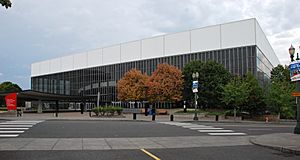

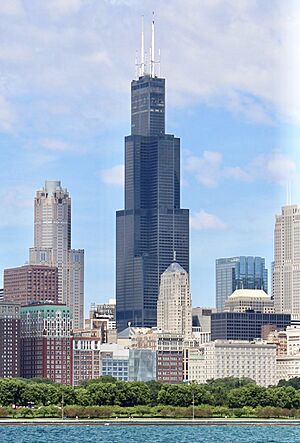
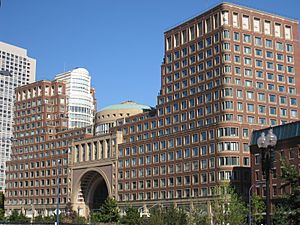
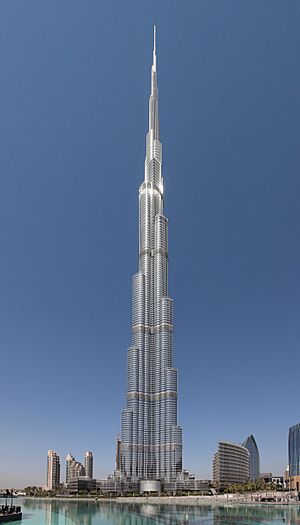
- Moynihan Train Hall, New York City, 2020
- United Nations Office at Geneva, renovation, 2020
- Haeundae LCT The Sharp, Busan, South Korea, 2019
- Guoco Tower, Singapore, 2018
- The Stratford / Manhattan Loft Gardens, London, England, 2018
- Barnard College, The Milstein Center, New York City, 2018
- University of Connecticut, Innovation Partnership Building, Storrs, Connecticut, 2018
- NATO Headquarters, Brussels, Belgium, 2017
- Cornell Tech Master Plan, New York City, 2017
- Chronicle Tower, London, 2016
- U.S. Air Force Academy, Center for Character and Leadership Development, Colorado Springs, Colorado, 2016
- Chicago Public Library, Chinatown Branch, Chicago, Illinois, 2015
- 350 Mission Street, San Francisco, 2015
- One World Trade Center, New York City, 2014
- Denver Union Station, Denver, Colorado, 2014
- Chhatrapati Shivaji Maharaj International Airport – Terminal 2, Mumbai, India, 2014
- Cayan Tower – Dubai, United Arab Emirates, 2013
- University Center, The New School, New York City, 2013
- Pearl River Tower, Guangzhou, China, 2013
- Al Hamra Tower, Kuwait City, Kuwait, 2011
- John Jay College of Criminal Justice, New York City, 2011
- Burj Khalifa, Dubai, United Arab Emirates, 2010
- Zifeng Tower, Nanjing, China, 2010
- Smithsonian National Museum of American History, Washington, D.C., 2008
- Cathedral of Christ the Light, Oakland, California, 2008
- U.S. Embassy, Beijing, China, 2008
- Toronto Pearson International Airport, Terminal 1, 2008
- Changi International Airport, Terminal 3, Changi, Singapore, 2007
- Tokyo Midtown, Tokyo, Japan, 2007
- 7 World Trade Center, New York City, 2006
- Time Warner Center, New York City, 2004
- Chongming Island Master Plan, Shanghai, China, 2004
- Greenwich Academy, Upper School, Greenwich, Connecticut, 2002
- Millennium Park Master Plan, Chicago, 2002
- 383 Madison Avenue, New York City, 2002
- Ben Gurion International Airport, Tel Aviv, Israel, 2002
- John F. Kennedy International Airport, International Arrivals Building, Terminal 4, New York City, 2001
- San Francisco International Airport, International Terminal, San Francisco, 2000
- Altice Arena (formerly Pavilhão Atlântico) Lisbon, Portugal, 1998
- Jin Mao Tower, Shanghai, 1998
- Matitone, Genoa, Italy, 1992
- 1540 Broadway, New York City, 1990
- One Worldwide Plaza, New York City, 1989
- Rowes Wharf, Boston, Massachusetts, 1986
- National Mall Redevelopment, Washington, D.C., 1986
- 63 Building, Seoul, South Korea, 1985
- Northeast Corridor Improvement Project, 1985
- Demonet Building, Washington, D.C., 1984
- Hubert H. Humphrey Metrodome, Minneapolis, Minnesota, 1982
- Hajj Terminal, King Abdul Aziz International Airport, Jeddah, Saudi Arabia, 1981
- Marriott World Trade Center, New York City, 1981 [Destroyed in 2001]
- PNC Center (Cleveland), Cleveland, 1980
- Louise M. Davies Symphony Hall, San Francisco, 1980
- First Canadian Centre, Calgary, Alberta, 1979
- Texaco Headquarters, White Plains, New York, 1977
- Azadi Stadium, Tehran, 1974
- Willis Tower (formerly Sears Tower), Chicago, 1974
- One Shell Plaza, Houston, Texas, 1972
- Seneca One Tower, Buffalo, New York, 1972
- One Shell Square, New Orleans, Louisiana, 1972
- Weyerhaeuser Corporate Headquarters, Federal Way, Washington, 1971
- Republic Newspaper Office and Printing Plant, Columbus, Indiana, 1971
- John Hancock Center, Chicago, 1970
- 140 Broadway, New York City, 1967
- Oakland Arena, Oakland, California, 1966
- Oakland-Alameda County Coliseum, Oakland, California, 1966
- Banque Lambert, Brussels, Belgium, 1964
- Cook County Administration Building (formerly the Brunswick Building), Chicago, 1964
- Beinecke Rare Book and Manuscript Library, Yale University, New Haven, Connecticut, 1963
- Albright-Knox Art Gallery, Extension, Buffalo, New York, 1962
- United States Air Force Academy, Colorado Springs, Colorado, 1962
- 28 Liberty Street (Chase Manhattan Bank Building), New York City, 1961
- Veterans Memorial Coliseum, Portland, Oregon, 1960
- Union Carbide Building, New York City, 1954
- 500 Park Avenue (Pepsi-Cola Corporation World Headquarters), New York City, 1960
- Inland Steel Building, Chicago, 1958
- Connecticut General Life Insurance Company, Bloomfield, Connecticut, 1957
- Manufacturers Trust Company Building, New York City, 1954
- Naval Station Great Lakes, Chicago, 1954
- Lever House, New York City, 1952
- Manhattan House, New York City, 1951
- Oak Ridge New Town Master Plan, Oak Ridge, Tennessee, 1949
- Terrace Plaza Hotel, Cincinnati, Ohio, 1948
Images for kids
-
The Light Inside by James Turrell
-
Current, Columbus, OH, 2023 By Janet Echelman
See also
 In Spanish: Skidmore, Owings and Merrill para niños
In Spanish: Skidmore, Owings and Merrill para niños



